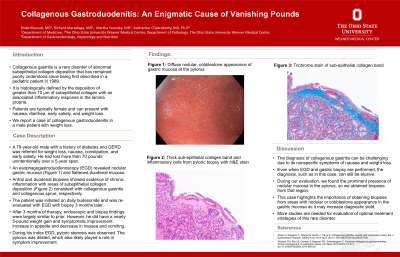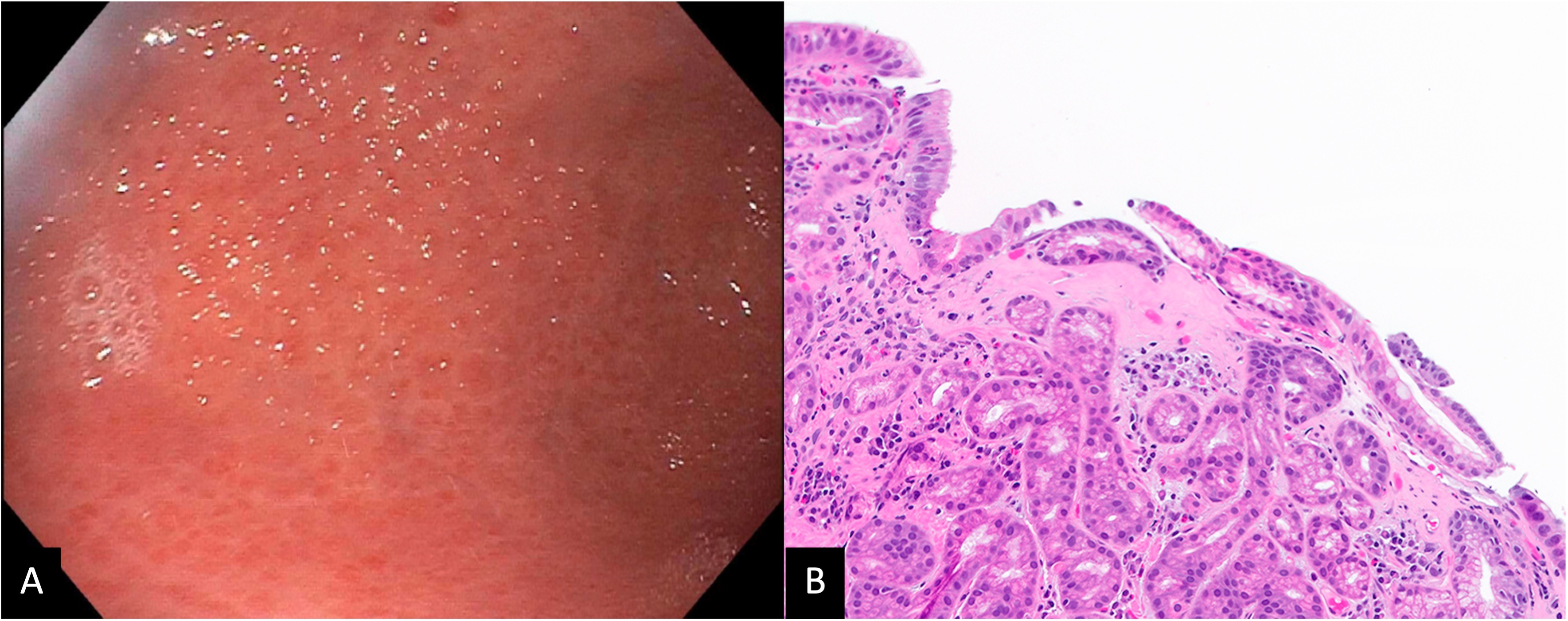Tuesday Poster Session
Category: IBD
P3664 - An Enigmatic Cause of Vanishing Pounds
Tuesday, October 24, 2023
10:30 AM - 4:00 PM PT
Location: Exhibit Hall

Has Audio

Shiab Mussad, MD
The Ohio State Wexner Medical Center
Columbus, OH
Presenting Author(s)
Shiab Mussad, MD1, Richard Maradiaga, MD2, Martha Yearsley, MD3, Subhankar Chakraborty, MD, PhD3
1The Ohio State Wexner Medical Center, Columbus, OH; 2Ohio State University Wexner Medical Center, Columbus, OH; 3The Ohio State University, Columbus, OH
Introduction: Collagenous gastritis is a rare disorder of abnormal subepithelial collagen deposition that has remained poorly understood since being first described in a pediatric patient in 1989. It is histologically defined by the deposition of greater than 10 μm of subepithelial collagen with an associated inflammatory response in the lamina propria. Patients are typically female and can present with nausea, diarrhea, early satiety, and weight loss. We report a case of collagenous gastroduodenitis in a male patient with weight loss.
Case Description/Methods: A 79-year-old male with a history of diabetes and GERD was referred for weight loss, nausea, constipation, and early satiety. He had more than 70 pounds unintentionally over a 5-year span, with much of that occurring within the preceding months. The patient had no history of chronic nonsteroidal anti-inflammatory drug, steroid or alcohol use. Prior evaluation for Helicobacter pylori and celiac disease was negative. An esophagogastroduodenoscopy (EGD) revealed nodular gastric mucosa (Figure 1) and flattened duodenal mucosa. Antral and duodenal biopsies showed evidence of chronic inflammation with areas of subepithelial collagen deposition (Figure 2) consistent with collagenous gastritis and collagenous sprue, respectively. The patient was initiated on daily budesonide with plans for repeat upper endoscopy after 3 months.
Discussion: The diagnosis of collagenous gastritis can be challenging due to its nonspecific symptoms of nausea and weight loss. Even when EGD and gastric biopsy are performed, the diagnosis, such as in this case, can still be elusive. During our evaluation, we found the prominent presence of nodular mucosa in the pylorus, so we obtained biopsies from that region. This case highlights the importance of obtaining biopsies from areas with nodular or cobblestone appearance in the gastric mucosa as it may increase diagnostic yield.

Disclosures:
Shiab Mussad, MD1, Richard Maradiaga, MD2, Martha Yearsley, MD3, Subhankar Chakraborty, MD, PhD3. P3664 - An Enigmatic Cause of Vanishing Pounds, ACG 2023 Annual Scientific Meeting Abstracts. Vancouver, BC, Canada: American College of Gastroenterology.
1The Ohio State Wexner Medical Center, Columbus, OH; 2Ohio State University Wexner Medical Center, Columbus, OH; 3The Ohio State University, Columbus, OH
Introduction: Collagenous gastritis is a rare disorder of abnormal subepithelial collagen deposition that has remained poorly understood since being first described in a pediatric patient in 1989. It is histologically defined by the deposition of greater than 10 μm of subepithelial collagen with an associated inflammatory response in the lamina propria. Patients are typically female and can present with nausea, diarrhea, early satiety, and weight loss. We report a case of collagenous gastroduodenitis in a male patient with weight loss.
Case Description/Methods: A 79-year-old male with a history of diabetes and GERD was referred for weight loss, nausea, constipation, and early satiety. He had more than 70 pounds unintentionally over a 5-year span, with much of that occurring within the preceding months. The patient had no history of chronic nonsteroidal anti-inflammatory drug, steroid or alcohol use. Prior evaluation for Helicobacter pylori and celiac disease was negative. An esophagogastroduodenoscopy (EGD) revealed nodular gastric mucosa (Figure 1) and flattened duodenal mucosa. Antral and duodenal biopsies showed evidence of chronic inflammation with areas of subepithelial collagen deposition (Figure 2) consistent with collagenous gastritis and collagenous sprue, respectively. The patient was initiated on daily budesonide with plans for repeat upper endoscopy after 3 months.
Discussion: The diagnosis of collagenous gastritis can be challenging due to its nonspecific symptoms of nausea and weight loss. Even when EGD and gastric biopsy are performed, the diagnosis, such as in this case, can still be elusive. During our evaluation, we found the prominent presence of nodular mucosa in the pylorus, so we obtained biopsies from that region. This case highlights the importance of obtaining biopsies from areas with nodular or cobblestone appearance in the gastric mucosa as it may increase diagnostic yield.

Figure: Figure 1. (Left) Granular appearence of the stomach on endoscopy
Disclosures:
Shiab Mussad indicated no relevant financial relationships.
Richard Maradiaga indicated no relevant financial relationships.
Martha Yearsley indicated no relevant financial relationships.
Subhankar Chakraborty: Coloplast – Consultant. Medtronic – Consultant.
Shiab Mussad, MD1, Richard Maradiaga, MD2, Martha Yearsley, MD3, Subhankar Chakraborty, MD, PhD3. P3664 - An Enigmatic Cause of Vanishing Pounds, ACG 2023 Annual Scientific Meeting Abstracts. Vancouver, BC, Canada: American College of Gastroenterology.
